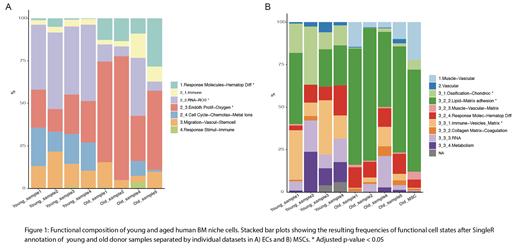Hematopoietic stem cells (HSCs), reside in a specialized bone marrow (BM) microenvironment known as the hematopoietic stem niche. Despite the critical role of the niche in tightly controlling the processes of normal and malignant hematopoiesis, its cellular composition remains only partially understood. Recent studies, including our own, using single-cell RNA sequencing (scRNA-seq) approaches have provided valuable insights into the profiling of the human BM niche. However, a comprehensive effort to describe the cellular heterogeneity and regulatory circuitry of the aged BM microenvironment in elderly humans is still lacking. As individual age, multiple systems and organs experience a progressive loss of anatomical and physiological integrity. Aging of the HSC niche is accompanied by a reduction in the numbers and function of its constituents and a decrease in the levels of HSC-supporting factors. Whether niche aging can contribute to the defects observed in aged hematopoiesis, such as the clonal shift towards myelopoiesis, the decrease in immune surveillance, or age-associated metabolic diseases, remains unresolved. To address this, we utilized scRNA-seq and spatial transcriptomics to provide a detailed characterization of the molecular landscape and stromal interactions in the aged non-immune BM microenvironment.
First, we performed scRNA-seq profiling on fluorescence-activated cell sorting-purified endothelial cells (ECs, TO-PRO-3 -/CD45 -/CD235 -/Lin -/CD31 +/CD9 +) and mesenchymal stromal cells (MSCs, TO-PRO-3 -/CD45 -/CD235 -/Lin -/CD271 +) from human BM samples of young (n=4) and elderly healthy donors (n=5). We analyzed a total of 1514 ECs and 3848 MSCs from older adults, grouped into 7 and 10 subclusters, respectively, defining distinct functional cell states. ECs and MSCs cells from young individuals were annotated using SingleR, utilizing the gene signature of each functional state in the elderly as a reference. Our results revealed significant shifts in the distribution of the functional states of BM niche cells during aging. Regarding ECs, we noticed reduced pathways associated with the cell cycle and RNA transcription pathways, indicating impaired cell cycle activity, coupled with decreased antioxidant defense (Figure 1A). In contrast, there was an increase in subgroups related to the response to foreign molecules, immune system activation, and vascular remodeling, suggesting an inflammatory response and increased vascular remodeling processes associated with aging. For MSCs, we observed a decline in osteogenesis and a reduction in the proportion of the early mesenchymal group related to immunity and the extracellular matrix (Figure 1B). These changes could contribute to the decreased ability of MSCs in elderly individuals to maintain HSCs function. On the contrary, we noticed increased adipogenic differentiation to the detriment of osteogenesis, which could be responsible for osteoporosis problems.
Next, and to further explore the location and the direct interactions between niche cells, we are currently integrating spatially resolved transcriptomics with our scRNA-seq data to accurately comprehend the spatial distribution and interactions among the BM niche cells, using for the first time 10x Genomics Visium Spatial Gene Expression on bone BM tissue in humans. As a final validation step, we are using a mouse model to validate further the mechanisms of age-associated changes in the BM microenvironment.
In summary, our results provide valuable insights into age-related transcriptional alterations in human BM ECs and MSCs, suggesting altered behavior of these niche cells during the aging of the hematopoietic system. This deeper understanding of the architecture of the aged hematopoietic system and its microenvironment offers the potential for developing novel therapeutic strategies preventing the detrimental effects of aging.
Disclosures
Paiva:Roche Glycart AG: Honoraria, Research Funding; Bristol-Myers Squibb: Consultancy, Honoraria, Research Funding; Janssen: Consultancy, Honoraria; Sanofi: Consultancy, Honoraria, Research Funding; EngMab: Research Funding; GSK: Honoraria, Research Funding; Takeda: Honoraria, Research Funding; Adaptive: Honoraria; Amgen: Honoraria; Gilead: Honoraria; Oncopeptides: Honoraria.


This feature is available to Subscribers Only
Sign In or Create an Account Close Modal